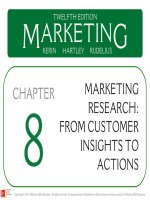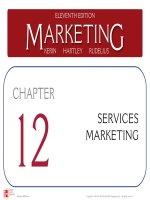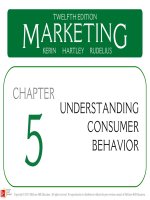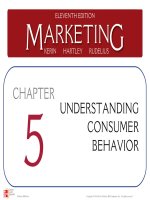Lecture Marketing: The core (5/e): Chapter 1 – Kerin, Hartley, Rudelius
Bạn đang xem bản rút gọn của tài liệu. Xem và tải ngay bản đầy đủ của tài liệu tại đây (3.14 MB, 29 trang )
McGrawHill/Irwin Copyright © 2013 by The McGrawHill Companies, Inc. All rights reserved.
LEARNING OBJECTIVES (LO)
AFTER READING CHAPTER 1, YOU SHOULD BE ABLE TO:
LO1
Define marketing and identify the
diverse factors influencing marketing
activities.
LO2
Explain how marketing discovers and
satisfies consumer needs.
LO3
Distinguish between marketing mix
factors and environmental forces.
12
LEARNING OBJECTIVES (LO)
AFTER READING CHAPTER 1, YOU SHOULD BE ABLE TO:
LO4
Explain how organizations build strong
customer relationships and customer
value through marketing.
LO5
Describe how today’s customer
relationship era differs from prior eras.
13
DISCOVERING HOW COLLEGE STUDENTS STUDY
HELPS LAUNCH A NEW PRODUCT AT 3M
Discovering
Student
Study Needs
Satisfying
Student
Study Needs
14
LO1
WHAT IS MARKETING?
You Are a Marketing Expert Already
• Involved in 1,000s of Buying Decisions
• May Be Involved in Selling Decisions
Marketing is NOT Easy
15
FIGURE 1-1 The see-if-you’re-really-amarketing-expert test
1. True
2. True
3. (c) plastic bottles
16
LO1
WHAT IS MARKETING?
DELIVERING BENEFITS
Marketing Seeks to:
• Discover Needs and Wants of Customers
• Satisfy Them
Exchange
AMA Definition of Marketing
17
LO1
WHAT IS MARKETING?
DIVERSE FACTORS INFLUENCE MARKETING ACTIVITIES
The Organization Itself and
Its Departments
Society
Environmental
Forces
18
FIGURE 1-2 A marketing department relates
to many people, organizations, and
environmental forces
19
LO1
WHAT IS MARKETING?
REQUIREMENTS FOR MARKETING TO OCCUR
Two + Parties with
Unsatisfied Needs
A Desire and Ability
to be Satisfied
A Way for the Parties
to Communicate
Something
to Exchange
110
LO2
HOW MARKETING
DISCOVERS CONSUMER NEEDS
THE CHALLENGE: NEW PRODUCTS
Consumers May Not Know or Cannot
Describe What They Need or Want
Most New Products Fail
The Challenge:
• “Focus on the Consumer Benefit”
• “Learn From the Past”
111
LO2
Dr. Care Vanilla-Mint Aerosol Toothpaste
What “benefits” and what “showstoppers?”
112
LO2
Terrafugia Transition
What “benefits” and what “showstoppers?”
113
LO2
Pepsi Next
What “benefits” and what “showstoppers?”
114
LO2
HOW MARKETING
DISCOVERS CONSUMER NEEDS
NEEDS VS. WANTS
Need
Does Marketing Persuade
People to Buy the
“Wrong” Things?
Market
Want
115
FIGURE 1-3 Marketing seeks to discover
consumer needs through research and then
satisfy them with a marketing program
116
LO3
HOW MARKETING
SATISFIES CONSUMER NEEDS
Target Market
The 4 Ps: Controllable
Marketing Mix Factors
• Product
• Price
• Promotion
$499
• Place
117
LO3
HOW MARKETING
SATISFIES CONSUMER NEEDS
Customer Value Proposition
Uncontrollable Environmental
Forces
• Social
• Competitive
• Economic
• Regulatory
• Technological
118
LO4
THE MARKETING PROGRAM
CUSTOMER VALUE AND RELATIONSHIPS
Customer Value
Value Strategies
• Best Price
• Best Service
• Best Product
119
LO4
Southwest Airlines, Starbucks, and Home Depot
What customer value strategy?
120
LO4
THE MARKETING PROGRAM
RELATIONSHIP MARKETING
Relationship Marketing
• Easy to Understand
• Hard to Do
Marketing Program
121
LO4
3M’S STRATEGY & MARKETING PROGRAM
HELPING STUDENTS STUDY
Move from Ideas to
a Marketable
Highlighter Product
Add the Post-it®
Flag Pen
Develop a Marketing
Program for the
Post-it® Flag
Highlighter and Pen
122
FIGURE 1-4 Marketing programs for two
new 3M Post-it® brand products targeted at
two distinct customer segments: college
students and office workers
123
LO4
3M STRATEGY & MARKETING PROGRAM
MARKETPLACE SUCCESS?
Developed Third
Generation Post-it®
Flag Highlighter
Appeared on
The Oprah
Winfrey Show
124
FIGURE 1-A Four different orientations in
the history of American business
Production Era
Sales Era
Marketing Concept Era
Customer Relationship Era
• Market Orientation
125









